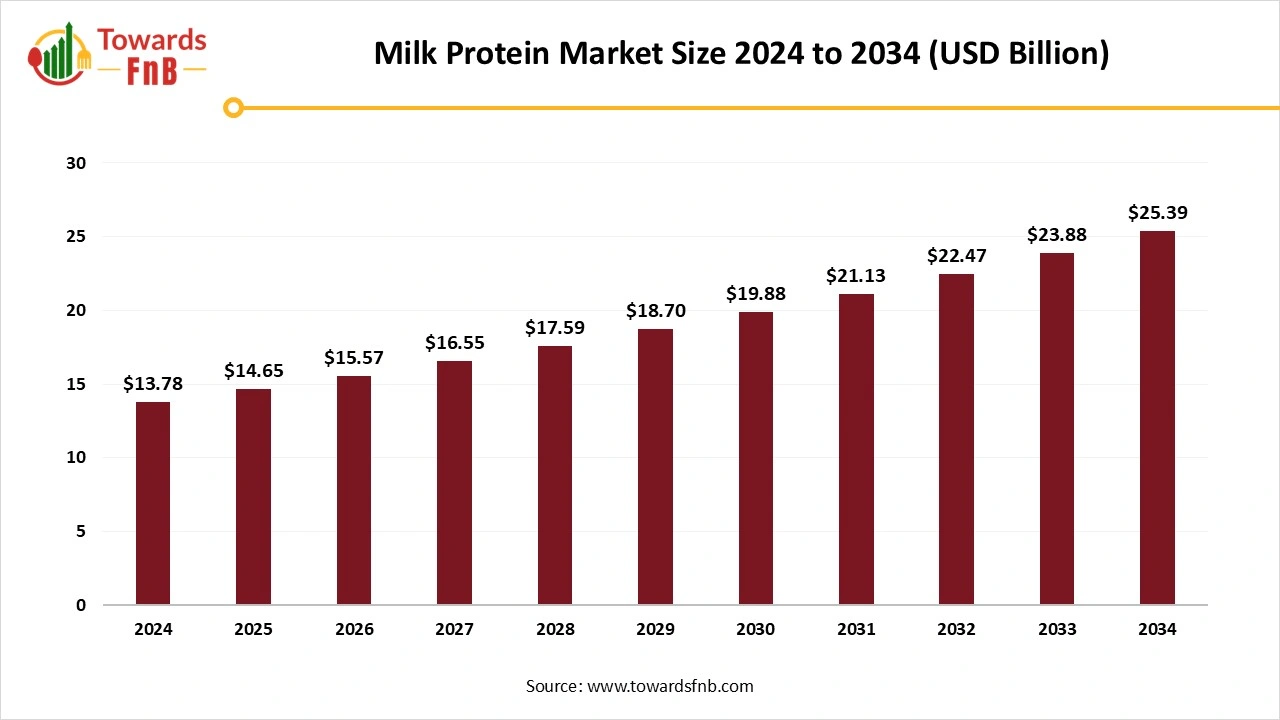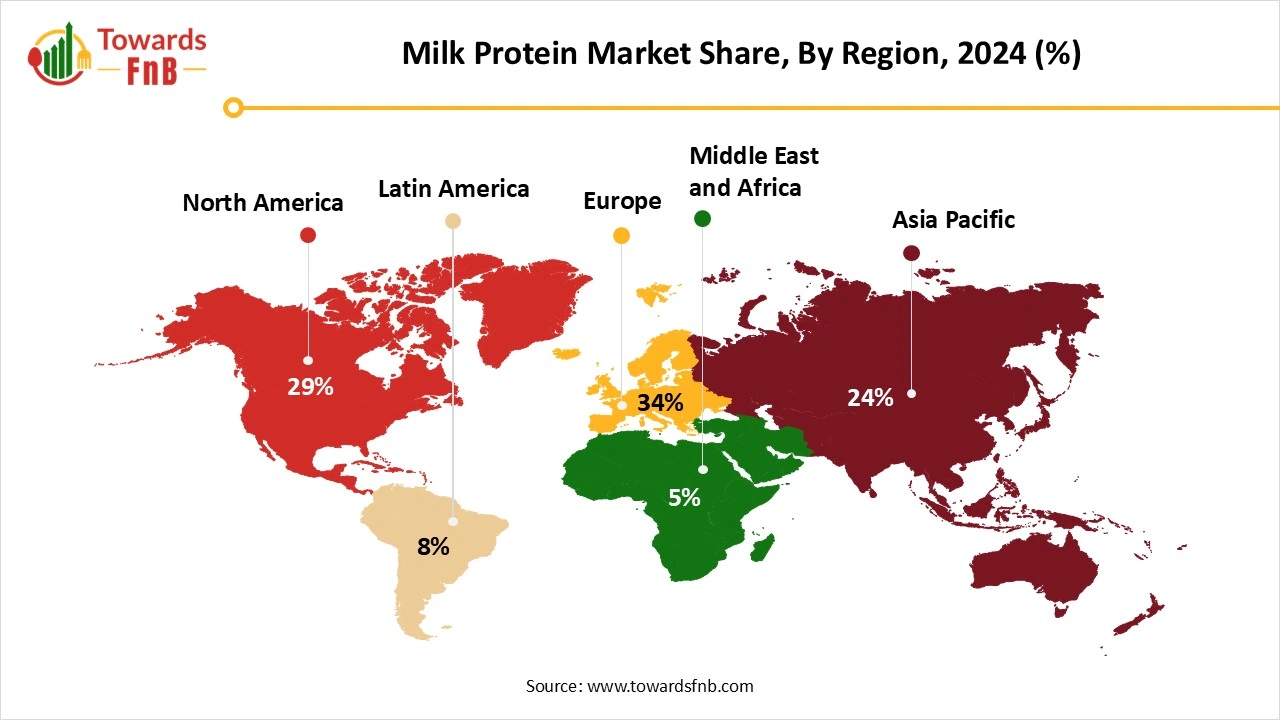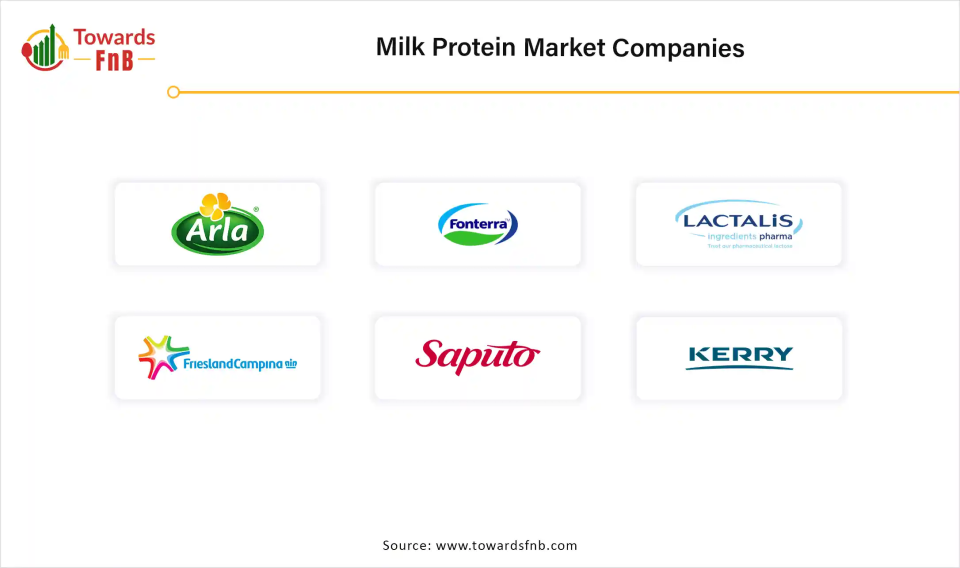December 2025
The global milk protein market size was calculated at USD 13.78 billion in 2024 with projections indicating a rise from USD 14.65 billion in 2025 to approximately USD 25.39 billion by 2034, expanding at a CAGR of 6.3% throughout the forecast period from 2025 to 2034. The market is driven by the increasing demand for protein-enriched, clean label and natural food products which are very beneficial for health-conscious consumers.

| Study Coverage | Details |
| Growth Rate from 2025 to 2034 | CAGR of 6.3% |
| Market Size in 2025 | USD 14.65 Billion |
| Market Size in 2026 | USD 15.57 Billion |
| Market Size by 2034 | USD 25.39 Billion |
| Largest Market | Europe |
| Base Year | 2024 |
| Forecast Period | 2025 to 2034 |
| Regions Covered | North America, Europe, Asia-Pacific, Latin America, and Middle East & Africa |
The milk protein market encompasses the production, processing, and distribution of proteins derived from milk, primarily casein and whey proteins. These proteins are extracted via physical or enzymatic processes and are sold in various forms (concentrates, isolates, hydrolysates) for use across a wide range of industries, including food & beverages, nutrition & health supplements, pharmaceuticals, cosmetics, and animal feed. The market is driven by rising health awareness, increasing protein consumption, clean-label preferences, and advancements in dairy processing technologies.
The milk proteins play an important role in various industries such as animal feed, pharmaceuticals and cosmetics. They are supporting muscle health. In addition, some of the major driving factors fueling the growth of the market, such as the increasing use of milk protein in processed food and beverages, increasing consumer preference towards sustainable and natural products and increasing demand for high-protein diets, especially in developed economics. Leading to the development of value-added products, milk protein allowed refinement and efficient extraction of dairy products, which further expected to drive the segment growth in the global market.
One of the significant opportunities revolutionizing the growth of the market is rising sustainability and production. The sustainable production of milk protein is highly connected to sustainable farming practices. To produce milk protein while reducing their ecological footprint, many dairy farms are adopting environmentally friendly methods. This includes practices such as enhancing the efficiency of resource use, reducing greenhouse gas emissions and improving animal welfare.
Consumers can contribute to more eco-friendly responsible food production systems, by choosing milk protein products from sustainable sources, which expected to revolutionize the growth of the milk protein market in the coming years.
One of the major restraining factors hindering the growth of the market is increasing consumer preference towards vegan food and beverages. The vegan population highly consuming food products which are plant-based food products and creates challenges in the consumption of animal-based food products. Instead, they consume the needed proteins and nutrients, such as plant milk protein, which further expected to restrain the growth of the milk protein market.
How Europe Dominates Market Revenue in 2024?
Europe dominated the milk protein market revenue in 2024. The market growth in the region is attributed to the factors such as the increasing consumer preference towards clean-label and natural ingredients, increasing focus on food innovations, and increasing consumption of high-protein dairy products, such as functional beverages, protein-enriched milk and Greek yogurt. The UK, France and Germany are dominating countries driving the market growth.

Germany dominated the market revenue in 2024, driven by the increasing demand for milk proteins in dietary supplements and sports nutrition, increasing consumer awareness towards health and wellness, increasing demand for functional beverages and protein-rich processed foods and rising growth in milk production and dairy industry.
Asia Pacific Milk Protein Market Trends
Asia Pacific is expected to grow fastest during the forecast period. The market growth in the region is driven by the increasing number of imports of milk protein, increasing demand for high-quality infant nutrition products, increasing focus on nutritional value, increasing consumer trend towards health and wellness, and increasing government support for dairy farming improvements. China, India, Japan and South Korea are the fastest growing countries driving the market growth.
India is expected to grow fastest during the forecast period, driven by the increasing prevalence of malnutrition, increasing health awareness and increasing demand for functional and nutritional foods. India is the fastest growing and huge country in the market due to rapidly growing agriculture industry.
How Whey Protein Segment Dominates Milk Protein Market Revenue in 2024?
The whey protein segment dominated the milk protein market revenue in 2025. Whey protein is a premium protein, rich in beneficial amino acids and derived from cow’s milk. Cow’s milk undergoes an extraction process, to make whey concentrated protein extract. Due to its rich content of macronutrients and vitamins, whey protein provides various benefits. Whey protein helps in the reduction of body fat and offers support for weight loss. Whey protein helps in development of new muscle, tissue repair and muscle and serves as an excellent muscle-building resource. In addition, reduces hunger, reduce blood cholesterol, enhances bodily antioxidant defenses, reduces inflammation in the body and helps treat type 2 diabetes are the major benefits driving the segment growth.
The Milk Protein Concentrates Segment is Expected to Grow Fastest During the Forecast Period.
The milk protein concentrates deal with dairy protein products that contains both whey proteins and caseins and can be produced through blending or ultrafiltration of dairy ingredients. The segment growth in the market is attributed to the increasing demand for functional and high-protein foods, increasing focus on wellness, fitness and health, rising advancements in processing technologies and increasing consumer preference towards personalized nutrition.
What Factors Help Powder Segment Grow in 2024?
The powder segment dominated the milk protein market revenue in 2024. The powder segment is widely used in various dry blends, such as milk powder, protein powder, and various powders. The segment provides longer shelf life and ease of storage, to make them appropriate for a wide range of food and beverage products, which may drive the segment growth. In addition, the powder segment is significantly contributing to market growth, due to the use in dietary supplements and nutritional products, which are expected to drive the segment growth in the global market.
The Liquid Segment is Expected to Grow Fastest During the Forecast Period.
The segment growth in the market is driven by the various benefits including versatility and ease of incorporation. Due to the perception and convenience, consumers are increasingly adopting milk protein shakes and other beverages. In addition, increasing demand for minimally processed and natural milk proteins, increasing consumer preference towards fitness trends, and increasing consumption of protein milk shakes are further expected to drive the growth of the market.
What Factors Help Cow Milk Segment Grow in 2024?
The cow milk segment dominated the milk protein market in 2024. Cow milk is a great source of protein, calcium, and calories for growing children. There are various health benefits of cow’s milk, such as helping infants to grow taller, helping fitness enthusiasts to make protein shakes, helping to make stronger teeth, necessary for the brain cells and nervous systems, and promoting a healthy heart, which may expect to drive the segment growth.
The Goat Milk Segment is Expected to Grow Fastest During the Forecast Period.
The segment growth in the market is driven by the increasing health and nutritional benefits related to goat milk, increasing demand in clinical and infant nutrition, increasing consumer awareness towards health and wellness, increasing prevalence of lifestyle-related diseases and increasing consumer preference towards eco-friendly and sustainability. In addition, the total population of goats is 1.09 billion across the globe. India is the second largest country in goat population with148.88 million goat population, which further accelerate the demand for goat milk.
How does Food & Beverage Segment Held the Largest Milk Protein Market Revenue in 2024?
The food and beverage segment dominated the milk protein market revenue in 2024. The segment growth in the global market is attributed to the growing food and beverage industries, increasing consumption of protein-rich milk shakes, increasing consumer awareness towards health and wellness, increasing demand for additive-free products and increasing environmental consciousness. In addition, the food and beverages deal with drinks and edible products by using goat milk as an ingredient, which includes, functional drinks, goat-milk-based desserts, protein milk powder, yogurt, cheese and liquid goat milk, which further increases the segment growth in the global market.
The Dietary Supplements Segment is Expected to Grow Fastest During the Forecast Period.
The segment growth in the market is driven by the increasing demand for protein rich supplement products, increasing demand from wellness and sports industry, growing population of working people and sports athletes, and increasing consumer preferences towards organic and clean label products.
Why Supermarkets and Hypermarkets Segment Held the Largest Milk Protein Market Revenue in 2024?
The supermarkets and hypermarkets segment dominated the market in 2024. The segment growth in the market is driven by increasing growth of in-store organic or natural sections, increasing accessibility of consumers and widespread reach, increasing demand for offline stores and increasing consumer desire to shop offline stores without waiting for online delivery. Hypermarkets and supermarkets are convenient for shopping for milk protein shakes and other products as these channels are consumer-friendly and convenient options for consumers. It has a convenient and longer shelf life. As consumers can shop for milk protein products of their choice, they can feel more comfortable and flexible while shopping with offline retail channels, which may fuel the demand for these retail channels in the global market.
The Online Platforms Segment is Expected to Grow Fastest During the Forecast Period.
The segment growth in the market is driven by factors such as increasing busy and modern lifestyles, growing e-commerce platforms, increasing consumer expenditure on milk protein products, increasing consumer trend for online shopping due to availability and easy access and increasing preference towards animal-based products and increasing high usage of internet penetration.
Why Solubility Segment Dominates the Milk Protein Market Revenue in 2024?
The solubility segment dominated the market revenue in 2024. The segment growth in the market is attributed to the increasing demand for easy-to-mix and ready-to-drink food products, increasing popularity of health drinks, and increasing focus on texture and taste to enhance consumer experience. The solubility segment deals with consumer acceptance and quality performance to improve dietary supplements products, which is expected to drive segment growth.
The Emulsification Segment is Expected to Grow Fastest During the Forecast Period.
The segment growth in the global milk protein market is driven by the rising technological advancements in processing methods, increasing demand for natural additives, improved longer shelf life, increasing use in processed foods and increasing better mixing of ingredients which helps mix water and oil in food products.
Promilk
HRX

By Product Type
By Form
By Source
By Application
By Distribution Channel
By Functionality
By Region
December 2025
December 2025
December 2025
December 2025